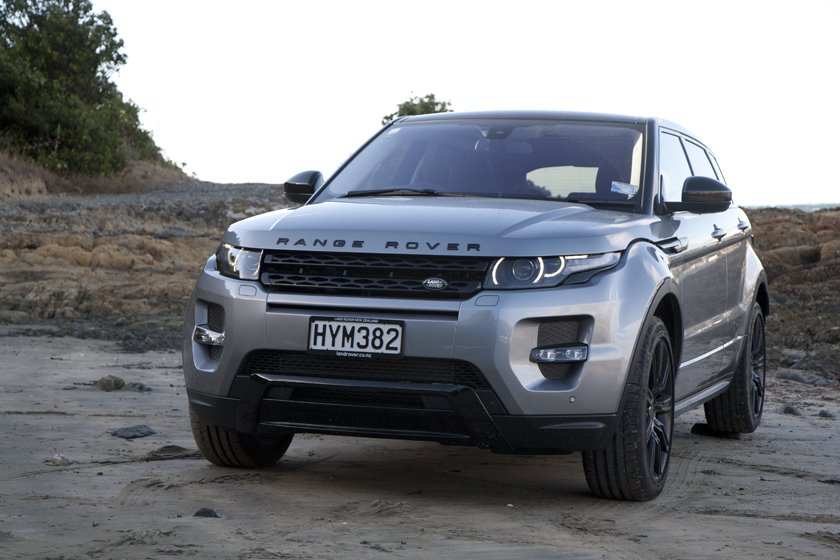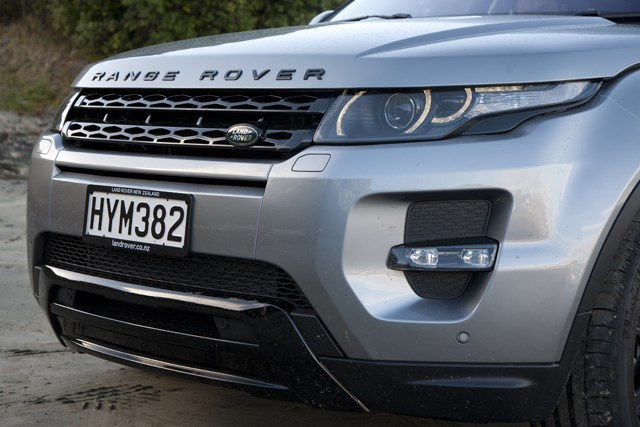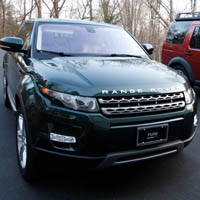
Jack Yan samples one of Lucire’s most acclaimed SUVs, in the form of the 2015½ Range Rover Evoque Si4 with Black Pack, and throws more than what you might expect at it
photographed by Stuart Cowley



 Beyond Chelsea If it has a Range Rover badge, it had better be capable—and it is
Beyond Chelsea If it has a Range Rover badge, it had better be capable—and it is
Jack Yan is publisher of Lucire.
In 2012, Lucire named the Range Rover Evoque our Car to Be Seen in. We had tested it Stateside, thanks to our resident Land Rover buff and New York photographer Stephen Ciuccoli, and while he wasn’t able to take it off-road, he felt it was a comfortable, well designed vehicle that had enough of the brand’s values. From a design point-of-view, we loved the courage Jaguar Land Rover had in launching it: it was barely changed from the Land Rover LRX concept car, and little details such as the gear selector dial, with its inspiration from audio systems, made the Evoque the style-conscious driver’s dream. It wasn’t quite classless—Land Rover wouldn’t want that to happen, since it gave the Evoque the Range Rover brand instead—but it did transcend the Sloane Ranger segment. The Evoque was embraced not just by the Sloane Street ladies, or those of Toorak and Parnell, but by buyers who wanted to express an individual style. And, unusually for a car with off-road capabilities, it was all right to keep it clean.
When we first covered the Evoque in 2010, we couldn’t expect that in 2015, it would still turn heads. But it does. Over the years, Land Rover has kept the car fresh with minor updates, and our test car, a 2015½ Si4 Dynamic five-door in Orkney Grey, a polished, metallic shade, with the optional Black Pack and 20-inch wheels, attracted attention as though it was fresh from a motor show. It didn’t matter who walked by, female or male, the Evoque still has that pulling power.
There’s still something about the car’s looks: the rising waistline is straight out of concept-car land, as are the wheels in proportion to the body. We boys, in particular, are the post-Matchbox Superfast generation, as the car designers have had the same influences, where big wheels equate to cool. The fact the grille, headlights and front wing vent appear visually as a single line, interrupted only by the front wheelarch, is a particularly clever touch, a design feature that marks out the Evoque’s design as original. Blacked-out details, in 2015, signal that this is the most stylish that one can get among Range Rover Evoque, and the designers have more than ably kept up with the latest trends. The panoramic roof, with its dark glass, added to that, where the Evoque’s grey body looked like a sleek slice of metal contrasted with lavish use of black. It is a designer’s design: the body, the colours and the details all attest to that.
Being the first publication to sample this particular Evoque—it was delivered to us with a single digit on the odometer—we savoured the experience. The little card detailing how we should take care of the leather upholstery was still intact in the rear seat in a brand-new car, and the cabin seemed a particularly sumptuous place to be. Given that the last Land Rover I drove prior to this was a first-generation Discovery, which still had the odd touch of agricultural roughness to it, the Evoque was from another dimension. Of course it has the Range Rover badge, which, since the 1980s, meant well-heeled luxury. At the top end, the full-size Range Rover is wider than a Rolls-Royce and more advanced, too, with its digital dashboard, the sort of thing we first saw in an S-Klasse Mercedes-Benz. It has become the last word in luxury, and the fact it happens to be capable off-road is a bonus for buyers who happen to own some country properties or have to duck into oil fields in the desert. The fact that Jaguar Land Rover has made the Evoque the last word in its segment was becoming very apparent. What impressed is that the cabin far out-guns anything from the Continent, with the way the perforated grained leather is stitched to the comfort of those front heated seats—a godsend for colder days.
It’s pleasant behind the driver’s seat. The Evoque’s eight-inch high-resolution touch-screen is what one would expect from a compact SUV that’s the top of the tree, and it’s sufficiently bright regardless of conditions. I did notice that Land Rover opted to use Eurostile instead of its corporate Foundry Monoline typeface, which could be down to licensing costs, and Eurostile was obvious throughout the interior. It’s a small issue, when BMW and Audi have their own corporate typefaces scattered throughout their interiors, and Range Rover, like Aston Martin, has skimped on this tiny detail. Only a typographer would ever notice.
But what is there on-screen is astounding. Of course there are the usual features, such as sat-nav, reversing camera and fuel economy readings, but one can change the ambient lighting (in five shades), so the interior lights up subtly along certain strips in the colour of your choice; it also informs you of your driving style and just how green you are, with read-outs on your acceleration and braking. Stealth mode shuts off the touch-screen so it doesn’t distract, although we joked that it would make the car disappear since it was the Black Pack. The Meridian 380 W sound system has 11 speakers, and produced the best sound of anything in this class that we’ve sampled in this magazine’s history.
However, it’s not the end of the gadgets. More about that later.
On the road, the Evoque continues to impress. Finding a driving position is easy; unlike some cars where you are forever adjusting to get comfortable, the Evoque is more forgiving with the steering wheel and seats. For urban use, its standard mode is perfectly serviceable: body roll is undetectable with the stability control, the ride is comfortable, and the vehicle is very refined, as one would expect from the Range Rover badge. British engineers have long been lauded for finding that magic spot between ride and handling, and the Evoque is right there. Taking it round the bends at Makara, known for its hilly roads and slightly tricky bends, the Evoque was consistently composed, its steering well weighted for feedback.
Things improve when the Evoque is put into the grass–gravel–snow mode as part of its Terrain Response System. This supposedly will make the power delivery to the wheels more progressive, and the traction control and dynamic stability control are more sensitive. The impression I had behind the wheel was that the car was firmer and more sure-footed, with power delivery to the rear wheels more noticeable.
For the majority of drivers, those two modes should do the trick. Evoques, like many SUVs in this segment, will never be off the Tarmac, with perhaps a gravel path their most challenging terrain. It was important enough to note that for the majority of drivers, this is as stylish as current Evoques get, you will turn heads, the seats are easy to fold down, it has a better sound system than inside your house, and you have a comfortable and commanding driving position that’s higher than the plebs’ in their Aurises.
However, there were two more modes there, and, as photographer Stuart Cowley and I mused, this was, after all, a Land Rover. The best 4×4×far. And lensman Cowley, after all, hails from the home of Jaguar Land Rover in the Midlands, and we couldn’t leave the road test at that.
continued below





We started our jaunt north in search of more difficult terrain, and found it at Battle Hill Farm Forest Park, where there was a bit of off-roading to do. Aware of our insurance obligations, we weren’t going to jeopardize the Evoque, but we wanted to see if it could handle some basic off-road duties should the occasion arise. There was a small creek where the grass–gravel–snow mode was perfect, and we wanted the car to carefully deliver the power to the wheels. The computers did all that without any fuss, and the Evoque felt surefooted over the water.
When things got muddy, we selected the Terrain Response system’s mud–ruts program, and the ABS kicked in, keeping things slow and steady. It’s not dissimilar to Land Rover’s Hill Descent Control, something pioneered back in the MG Rover days and wound up at BMW and Ford thanks to the company being bought by different businesses after British Aerospace sold it. However, you don’t need to be descending: we engaged mud–ruts on flat but difficult terrain, and the Evoque slowed down to ensure that we didn’t lose control.
The ride height, and the creek crossings, gave us a bit more confidence to try tougher fare. Another stream was present at the Farm, and it seemed the perfect chance to throw more rough stuff at it. With climate change and floods in the North and South Islands in 2015, the odds of the Evoque meeting more water were greater. Could it take it?
Selecting grass–gravel–snow again for the extra traction, the Evoque went to work, heading downward to the stream, with brief bumps on the bed before striking the water. The water went over the vehicle and it emerged at the other end, no worse for wear. The days of Land Rovers feeling a bit tinny were gone: the Evoque felt ready for more, and it would do so in full comfort. And yes, we did have to repeat the procedure a few times to get the perfect shot.
However, there was one final mode to test: driving on sand. Nearby beaches at Whitby and Titahi Bay were our destinations, and the Evoque made light work of the soft surfaces at the beach. We didn’t need to select mud–ruts given that the sand was not too wet, and there were no issues with the traction at either beach.
The Terrain Response in the Evoque doesn’t extend to the rock crawl mode that is present on the next models up, but given that few were likely to throw our tasks at it, there would be no need for Land Rover’s most extreme, low-range party trick here.
It’s perhaps no surprise that with a less than normal test, the usually economical nine-speed gearbox (a first for our test cars) didn’t get to show how frugal the car was when we averaged 25·4 mpg (Imperial) (11·12 ℓ/100 km) on the test. Official figures show that carbon dioxide emissions are at 181 g/km; for eco-friendly Evoques, one would have to opt for the eD4, available in other markets.
After that, we took the Evoque back to everyday Sloane Ranger life, where it was quite happy to be without a wash. While the majority of buyers will want their Black Pack cherished (and we note that we kept our alloys sparkling and fresh despite the terrain), it’s useful to know that it deserves the green Land Rover badge up front. That badge does, after all, bring with it 67 years of off-road history, of some of the world’s most difficult expeditions into the least forgiving terrain. The Range Rover Evoque cannot be what the Patriot is to Jeep: a lightweight model that noticeably is never advertised with that company’s ‘Trail Rated’ symbol. And it isn’t. For those contemplating the Range Rover Evoque, they can feel safe knowing that if they need to go beyond (either the literal or figurative) Sloane Square in Chelsea, they can. The Evoque is every inch a Range Rover. It’s like Charlize Theron: you know she has movie-star looks but she’s not afraid to go camping in Africa. •







Related articles hand-picked by our editors
 Evoking style in town and country
Evoking style in town and country
Among the Lucire team, photographer Stephen Ciuccoli knows Land Rovers more than the rest of us, so he was the perfect man to evaluate the most talked-about SUV of the year, the Range Rover Evoque
photographed by the author
 Victoria Beckham launches special edition Range Rover Evoque in Beijing
Victoria Beckham launches special edition Range Rover Evoque in Beijing
Land Rover débuted the Range Rover Evoque Victoria Beckham Special Edition just prior to the official opening of Auto China, the Beijing Motor Show
If you must have an SUV, few come better balanced than the BMW X3 Xdrive20d, says Jack Yan
photographed by the author
Advertisement
Copyright ©1997–2022 by JY&A Media, part of Jack Yan & Associates. All rights reserved. JY&A terms and conditions and privacy policy apply to viewing this site. All prices in US dollars except where indicated. Contact us here.